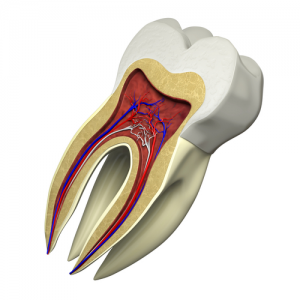
Getting a root canal requires oral surgery and may require some time to heal. If you have recently been suffering from toothaches or other pain inside your mouth then you should consider scheduling a dental appointment for further examination. Your dentist will be able to determine if a root canal is the best course of action. For those that have never had this operation before, learn more about root canals and find out when then they are necessary.
What is a Root Canal?
 First, you should understand exactly what a root canal is. Essentially, a root canal is the cavity that passes through the middle of a tooth. Inside this canal is pulp and the nerve of your tooth. Basically, the nerve is what allows you to feel the sensation of hot or cold on your tooth. When a tooth is decayed or has an infection, a root canal procedure may be needed. During this operation, the root canal is emptied, including the nerve and the pulp, the cavity is cleaned, and the tooth is sealed.
First, you should understand exactly what a root canal is. Essentially, a root canal is the cavity that passes through the middle of a tooth. Inside this canal is pulp and the nerve of your tooth. Basically, the nerve is what allows you to feel the sensation of hot or cold on your tooth. When a tooth is decayed or has an infection, a root canal procedure may be needed. During this operation, the root canal is emptied, including the nerve and the pulp, the cavity is cleaned, and the tooth is sealed.
As a tooth decays or the nerve tissue inside the tooth is damaged, that tooth becomes the perfect breeding ground for bacteria and infections. This can result in an abscessed tooth, which consists of pus at the end of the tooth’s roots. Other problems of an abscess include swelling, bone loss, and drainage issues. In addition to tooth decay, the nerve and pulp of your tooth can become damaged from cracks or chips in the tooth or damage from a preceding dental procedure.
How Can You Tell When a Root Canal is Necessary?
There are several signs to look for that point towards the need for a root canal procedure. You may notice a severe toothache or pain when chewing or when you apply pressure to the infected tooth. You could also have increased sensitivity or pain from hot or cold food or drink. Other signs include swelling, tenderness, and a discoloration of the tooth. If you experience any of these signs, schedule an appointment with a dentist as soon as possible.
What is the Process of Getting a Root Canal?
As briefly described above, the root canal procedure involves removing the tooth’s nerve and pulp, cleaning the inside of the tooth, and then sealing the tooth, but the first step is getting an x-ray to determine if the root canal is actually infected. If a root canal is needed, the area around the tooth will be numbed using anesthesia. Then a hole will be drilled into the tooth. All of the pulp, bacteria, nerves, and other debris is cleaned out of the inside of the tooth’s root canal.
During this procedure, the area is regularly flushed to remove debris. Once the cleaning out is completed, the dentist may wait several days before sealing the tooth. The inside of the root canal is then filled with a sealer paste. The original access hole that was drilled into the tooth is then covered with a filling. If the tooth was severely decayed, additional work may be required to restore the look of the tooth, but this is determined on a case by case basis.
For the next few days, you may experience some sensitivity around the tooth until the tissue is fully healed. Your dentist will probably also recommend that you attempt to avoid chewing with the tooth that had the root canal as much as you can. This will help prevent infection or chipping of the tooth.
If you have been experiencing pain or increased sensitivity around a particular tooth then schedule a dental appointment to find out if a root canal is necessary. Contact us at FP Essentials today to learn more or discuss available options.
